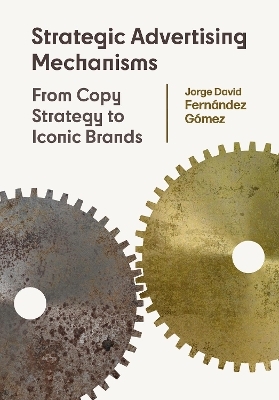
Strategic Advertising Mechanisms
Intellect Books (Verlag)
978-1-78938-430-7 (ISBN)
It is the first time that the different strategic advertising mechanisms are explained in a single book. And this is also the first time that a book has brought together the most important and transcendent (for its applicability to the advertising market) strategic advertising mechanisms.
The text explains from classic mechanisms such as Rosser Reeves's USP or Procter & Gamble's copy strategy to modern mechanisms such as Kevin Roberts's Lovemarks or Douglas Holt's iconic brands. It also considers European mechanisms such as Jacques Séguéla’s star strategy or Henri Joannis’s psychological axis. The book has the most complete academic review.
Strategic Advertising Mechanisms: From Copy Strategy to Iconic Brands, integrates the most important strategic advertising mechanisms developed throughout the time: USP, brand image, positioning, Lovemarks... This is the first and only book to date that compiles the most consolidated methods by advertisers or advertising agencies (P&G, Bates, Ogilvy or Euro) in the history of modern advertising.
Primary readership will be among practitioners, researchers, scholars and students in a range of disciplines, including communication, advertising, business and economic, information and communication, sociology, psychology and humanities. There may also be appeal to the more general reader with an interest in how advertising strategic planning works.
PhD (with distinction) in Brand Managament, is a lecturer in Communication at Universidad de Sevilla, Spain, and he has been a member of Department of Business Economics in the UCA. He collaborates with different universities such as Bryant University (USA) or Nova (Portugal). He has published thirteen books (McGraw-Hill, Hachette Livre, etc.) and papers in European and American academic journals. His research interests include brand management, popular culture, advertising strategy and advertising business. He has worked in advertising for clients like Google, Microsoft, Bankia, P&G, Tio Pepe, or Telefonica.
Foreword
Javier Suso
Introduction
1. Procter & Gamble’s Copy Strategy: When the Advertiser Made Products and Advertising
1.1. P&G or the prehistory of brand management
1.2. The birth of rationalist advertising
1.3. Reason why copywriting and Hopkins as the pillars of rationalist advertising
1.4. The copy strategy
2. Rosser Reeves’s USP: The Reality in Advertising Is the Product
2.1. The USP as a strategic advertising mechanism
2.2. What is the USP?
2.3. Characteristics of the USP or revamping the dominant idea
2.4. Critiques of the USP
3. David Ogilvy’s Brand Image: The Rise of Emotion in Advertising Communication
3.1. The influence of motivation research on emotional strategic advertising mechanisms
3.2. Pierre Martineau: The ambassador of emotional advertising
3.3. David Ogilvy’s brand image
3.4. Theoretical bases of brand image
3.5. Gardner and Levy’s ‘The product and the brand’: The acknowledged forerunner of brand image
4. Henri Joannis’s Psychological Axis: The Advent of Motivational Research in European Advertising
4.1. The psychological axis theory
4.2. Joannis’s proposals as addendums to Reeves’s theories
4.3. A mechanism for creating ads
5. Jacques Séguéla’s ‘Star Strategy’: Selling the Hollywood Star System to Sell Brands
5.1. The ‘star strategy’: A brand image evolution
5.2. ‘Star strategy’ characteristics: The cinema world as an advertising metaphor
5.3. The Chevron model in ‘give your brand in marriage’: The ‘star strategy’ revisited
6. Kevin Roberts’s Lovemarks: The Return of Emotional Mechanisms in the New Century
6.1. What is the Lovemarks effect?
6.2. The characteristics of the Lovemarks effect
6.3. Critiques of the Lovemarks effect
6.4. Creating Passionbrands: An example of updating personality branding on the basis of the redundancy principle
7. Jack Trout and Al Ries’s Positioning: The Appearance of Cognitive Psychology in Advertising
7.1. The origins of positioning
7.2. What is positioning?
7.3. Theoretical bases of positioning
7.4. Positioning seen from afar
7.5. The USP as the forerunner of positioning
8. Douglas Holt’s Iconic Brands: When Cognitive Psychology and Motivation Research Converge
8.1. Theoretical bases of iconic brands: The birth of cultural branding
8.2. The iconic brand concept
8.3. Principles underpinning the construction of iconic brands
8.4. Critiques of iconic brands
| Erscheinungsdatum | 27.09.2021 |
|---|---|
| Zusatzinfo | 2 Diagrams |
| Sprache | englisch |
| Maße | 170 x 244 mm |
| Themenwelt | Geisteswissenschaften ► Psychologie ► Allgemeine Psychologie |
| Geisteswissenschaften ► Psychologie ► Verhaltenstherapie | |
| Sozialwissenschaften ► Kommunikation / Medien ► Journalistik | |
| Wirtschaft ► Betriebswirtschaft / Management ► Marketing / Vertrieb | |
| ISBN-10 | 1-78938-430-3 / 1789384303 |
| ISBN-13 | 978-1-78938-430-7 / 9781789384307 |
| Zustand | Neuware |
| Informationen gemäß Produktsicherheitsverordnung (GPSR) | |
| Haben Sie eine Frage zum Produkt? |
aus dem Bereich


